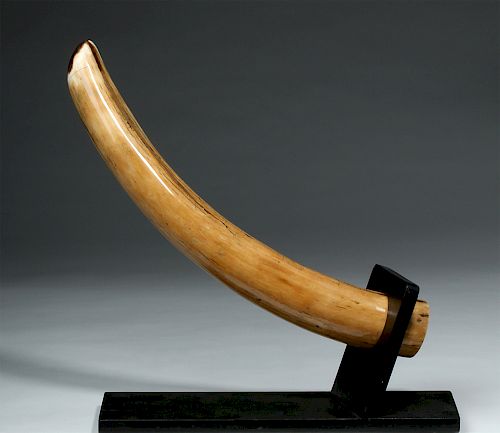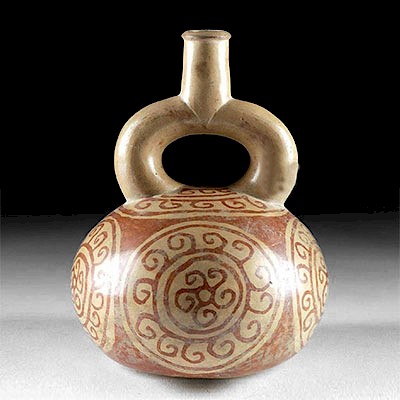Alaskan Mammoth Tusk, Late Pleistocene
Lot 92a
About Seller
Artemis Gallery
686 S Taylor Ave, Ste 106
Louisville, CO 80027
United States
Selling antiquities, ancient and ethnographic art online since 1993, Artemis Gallery specializes in Classical Antiquities (Egyptian, Greek, Roman, Near Eastern), Asian, Pre-Columbian, African / Tribal / Oceanographic art. Our extensive inventory includes pottery, stone, metal, wood, glass and textil...Read more
Estimate:
$4,800 - $7,200
Absentee vs Live bid
Two ways to bid:
- Leave a max absentee bid and the platform will bid on your behalf up to your maximum bid during the live auction.
- Bid live during the auction and your bids will be submitted real-time to the auctioneer.
Bid Increments
| Price | Bid Increment |
|---|---|
| $0 | $25 |
| $300 | $50 |
| $1,000 | $100 |
| $2,000 | $250 |
| $5,000 | $500 |
| $10,000 | $1,000 |
| $20,000 | $2,500 |
| $50,000 | $5,000 |
| $100,000 | $10,000 |
| $200,000 | $20,000 |
About Auction
By Artemis Gallery
Jan 24, 2019
Set Reminder
2019-01-24 10:00:00
2019-01-24 10:00:00
America/New_York
Bidsquare
Bidsquare : Pre-Columbian / Ethnographic Art
https://www.bidsquare.com/auctions/artemis-gallery/pre-columbian-ethnographic-art-3814
Featuring ancient and ethnographic art from around the world, including Pre-Columbian, Native American, African / Tribal, Ethnographic, Spanish Colonial, Fossils, Fine Art, much more. Artemis Gallery info@artemisgallery.com
Featuring ancient and ethnographic art from around the world, including Pre-Columbian, Native American, African / Tribal, Ethnographic, Spanish Colonial, Fossils, Fine Art, much more. Artemis Gallery info@artemisgallery.com
- Lot Description
North America, Alaska, Pleistocene epoch (Ice Age), ca. 35,000 years ago. A section of a tusk from a woolly mammoth (Mammuthus primigenius), mainly creamy brown, with some hints of a blue-green color. The same Alaskan mineral deposits that led to the gold rush of the 1890s has turned this huge mammoth tusk its distinctive blue green through the process of mineralization - after the animal's death, the tusk lay in soil containing the mineral Vivianite, which occurs near mineral ores, as in gold mines. Size: 25" L x 2.9" W (63.5 cm x 7.4 cm); 19.75" H (50.2 cm) on included custom stand.
While mammoths survived until ca. 5600 years ago on remote Alaskan islands, those animals had begun to shrink in size as the climate warmed from the end of the Ice Age ca. 10,000 years ago. A tusk of this size comes from deep within the Pleistocene, when the northern hemisphere was dominated by massive ice sheets drained by enormous glacial rivers and lakes. Imagine encountering this animal on an Ice Age steppe, towering up to 13 feet at the shoulder and weighing up to 12 tons, with this tusk and its partner rising in an upward curve from their jaw. Imagine the strength the animal's neck must have had just to hold up these massive teeth!
Please note that fossilized ivory tusks from any species cannot be shipped to the US States of California, Hawaii, Nevada, New Hampshire, New Jersey, New York, Oregon, and Washington State. As of 2019, they will not be able to be shipped to Illinois.
Provenance: private Hagar Collection, St. Louis, Missouri, USA
All items legal to buy/sell under U.S. Statute covering cultural patrimony Code 2600, CHAPTER 14, and are guaranteed to be as described or your money back.
A Certificate of Authenticity will accompany all winning bids.
We ship worldwide and handle all shipping in-house for your convenience.
#127524This is the tip of a full tusk, with a clean cut at the wide end. Polished, smooth, intact surface.Condition
- Shipping Info
-
All shipping is handled in-house for your convenience. Your invoice from Artemis Gallery will include shipping calculation instructions. If in doubt, please inquire BEFORE bidding for estimated shipping costs for individual items.
-
- Buyer's Premium



 EUR
EUR CAD
CAD AUD
AUD GBP
GBP MXN
MXN HKD
HKD CNY
CNY MYR
MYR SEK
SEK SGD
SGD CHF
CHF THB
THB















